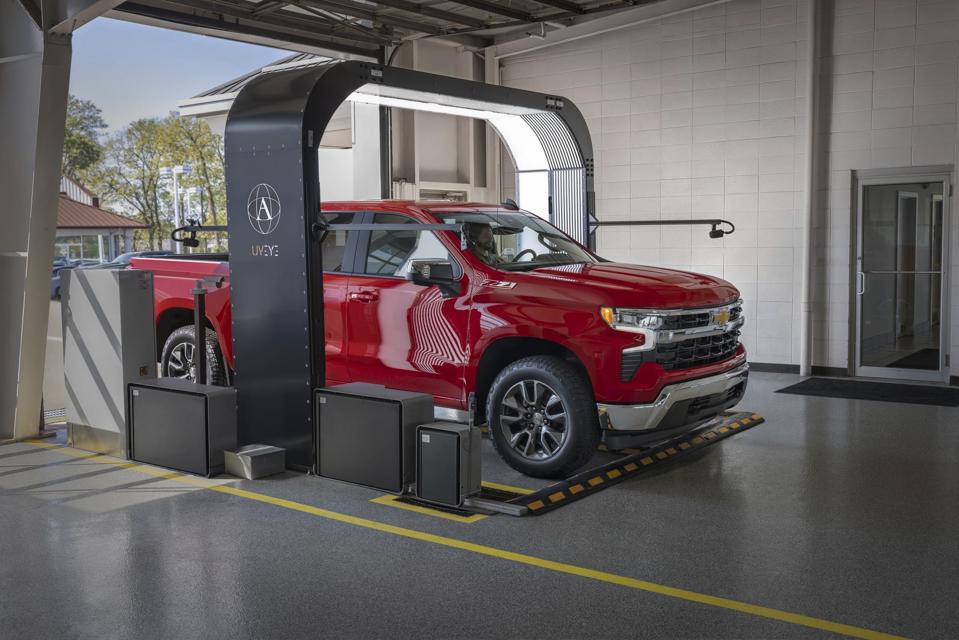UVeye Partnership With General Motors, Connexion Aims To Avoid Loaner Damage Conflicts and Reduce Dealer Walkarounds.

Disputes between auto dealerships and customers over damage to loaner or rental vehicles are a common challenge. A newly announced collaboration between UVeye, General Motors Co., and fleet management software provider Connexion Mobility aims to address that issue.
UVeye’s AI-powered, drive-through inspection stations—already installed at many GM dealerships—quickly detect damage and physical defects on a vehicle’s exterior, structure, and tires. Through this new partnership, GM dealers can now use UVeye inspections on their loaner and rental vehicles, with results integrated directly into Connexion’s OnTRAC platform. This documents vehicle condition before and after each customer use, with results also sent to customers by text message. “You know exactly what was the condition of the vehicle, you see exactly how you returned it. No one thinks that you’ve done any damage,” said Amir Hever, UVeye’s co-founder and CEO.
For GM dealerships already equipped with UVeye systems, inspecting loaner and rental fleets adds another layer of return on investment, noted Yaron Saghiv, UVeye’s chief marketing officer. “Over 4,000 dealers are going to be able to use this from day one, which is most of the GM network,” he said.
David Marsh, executive director of GM customer care and aftersales, called the initiative “a significant announcement for General Motors dealers,” adding: “The integration of OnTRAC and UVeye will not only streamline the loaner fleet process but also enhance the overall customer experience.”
GM first partnered with UVeye in 2022 to bring the inspection systems to its U.S. dealerships. At that time, GM became the fourth automaker to invest in UVeye, joining Hyundai Motors, Volvo, and Skoda.
Founded in Israel in 2016 by Amir and Ohad Hever, UVeye originally developed its inspection technology to detect contraband at international borders. Skoda was the first automaker to deploy UVeye systems at its manufacturing plants in 2018 to identify defects during production. Since then, UVeye has expanded operations, opening U.S. offices in Teaneck, N.J., and Norcross, Ga.
“We’re continuing to support Amazon and their rollout to more distribution centers. We continue working and expanding with Carmax. We’re installing a lot more GM dealerships,” said Hever. “It’s over 350,000 unique cars a month and we think that we’re going to at least triple it in 2024. We’re installing over 30 systems a month now.”
The company offers three inspection systems tailored for dealerships, auctions, and large fleets:
Helios: An underbody scanner detecting issues like frame damage, missing components, fluid leaks, and problems with brake and exhaust systems.
Artemis: A tire inspection system that in seconds evaluates brand, specifications, air pressure, tread depth, sidewall damage, mismatched tires, and alignment issues.
Atlas and Atlas Lite: A 360-degree exterior inspection system checking sheet metal, bumpers, door locks, grilles, and windows. Atlas Lite is optimized for dealership use.
Artemis, in particular, has highlighted how the heavier weight of EV batteries is accelerating tire wear compared to vehicles with internal combustion engines. “We are starting to work with tire manufacturers to help them with the remodeling of the tires, especially for the EVs now that we’re seeing that there is a big change,” said Hever. “We’re working with the OEMs to share with them kind of the insights that we’re seeing from the market.” He added that UVeye plans to publish findings from its EV tire inspections soon to raise awareness among automakers and consumers.
Regarding the new GM and Connexion partnership, Hever explained it’s not intended as a direct revenue stream for UVeye, but rather as added value for its customers. “We’re trying to create more value to our customers, not necessarily by selling them more services, but leveraging the existing services—how they can use it for other use cases,” he said.